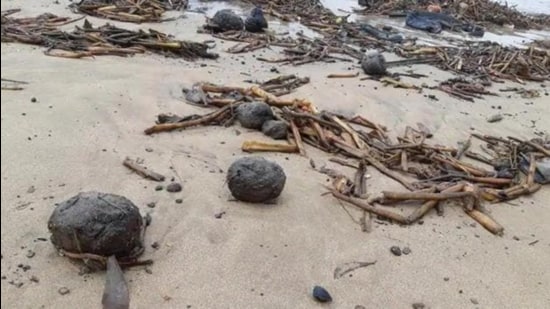Goa beaches sullied by tarballs; fishermen, tourism stakeholders worried
The menace of tarballs, greasy blobs of thick black oil that wash ashore, has once again afflicted beaches in Goa this year with increased severity covering several beaches including those popular with tourists like Anjuna with the black sticky carpet
The menace of tarballs, greasy blobs of thick black oil that wash ashore, has once again afflicted beaches in Goa this year with increased severity covering several beaches including those popular with tourists like Anjuna with the black sticky carpet.

The phenomenon which occurs every year with varying intensity has been found on beaches in North Goa including along the sands of the Miramar beach in the capital city, Anjuna beach in North Goa as well as beaches further North including Morjim, Mandrem, Keri, as well as Colva beach in South Goa. Fishermen and tourism stakeholders have urged the Goa government to resolve the worsening environmental issue.
Speaking to HT, Olencio Simoes, general secretary of the National Fishworkers Forum, said the tarballs were forcing the fishermen, especially the traditional ones, to dump their catch.
“It happens every year, but this year the problem has been especially severe. The shellfish is completely covered in the tar and the entire colonies die out. Besides that, the nets are completely covered in tar and we have to throw the fish out as they cannot be cleaned,” Simoes said.
“Tarballs can attract various heavy metals, including nickel, copper, and cobalt, to their surfaces. Due to different weathering processes, tarballs can accumulate high concentrations of heavy hydrocarbons, organic compounds that only contain carbon and hydrogen, such as polycyclic aromatic hydrocarbons (PAH). This also causes cancer in humans besides complete destruction of marine life and loss to the livelihoods of thousands of fishermen,” he said.
On Monday, a delegation of locals called on North Goa MP and Union minister of state for shipping Shripad Naik asking him to address the issue.
A study by scientists at the National Institute of Oceanography, which backtracked the origin of the tarballs and using sea surface current modelling as well as chemical fingerprinting, found that the source of tarballs that arrive after the monsoons was used oil dumped in the sea by tankers that pass between the Middle East and South-East Asia. The tarballs that arrived in May were found to be crude oil spills from the Bombay High region.
Tarballs are caused by the churning of the oil with seawater to become a thick paste which then washes ashore in the monsoons with the water currents. Some of the balls are as big as a dung cake while others are smaller globules that are a major irritant to those bathing in the sea or walking along the beach as they stick to the skin and are very difficult to wash off, the study said.
The NIO also found that the Goan coast was close to one of the Sea Lines of Communication (SLOC), which is used by ships and international oil tankers coming from and going towards the Persian Gulf. Hence, all the oil spilt in the Arabian sea eventually gets deposited on the western coast in form of tarballs in the monsoon season when wind speed and circulation pattern favour transportation of these tarballs, the study said.
Last year, Goa environment minister Nilesh Cabral wrote to the then Union environment minister Prakash Javadekar seeking help in tackling the problem.
“We have tracked down the source of these tarballs after studying the phenomenon. We have written to the MoEF about the matter. The Central ministry will now study our findings before taking measures to address the issue which we have raised,” Cabral said.
The Goa government officials said they were trying to find reasons for high tarball deposition on coasts this year as compared to previous years.



